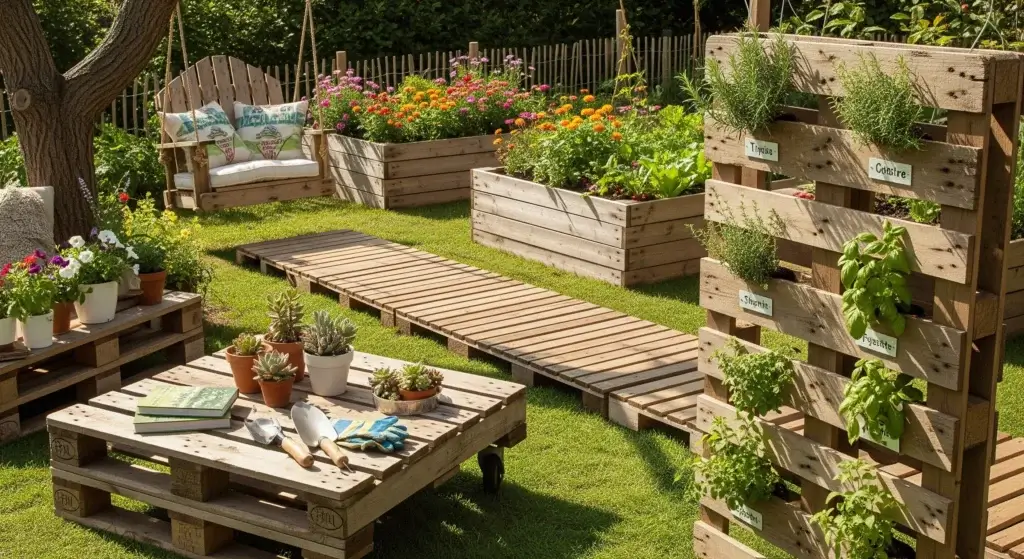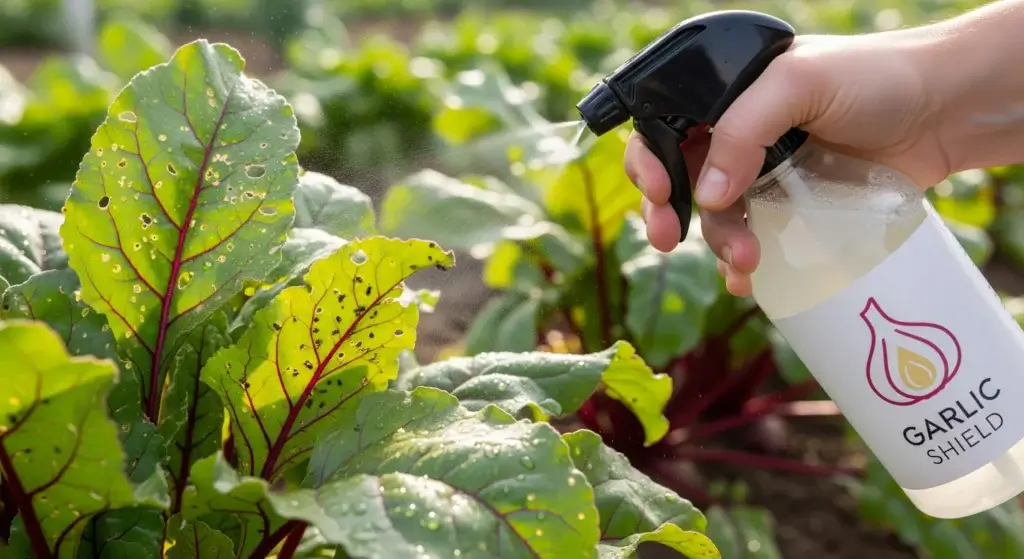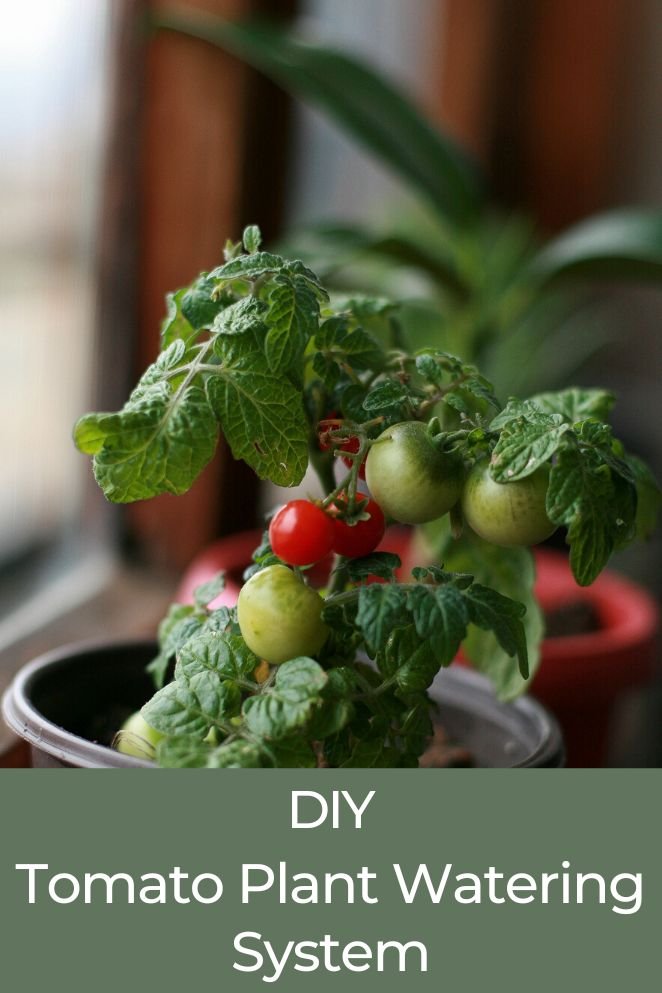
Embarking on the journey of cultivating thriving tomato plants?
The secret to their success lies in a well-thought-out watering system.
In this guide, we’ll explore the benefits of implementing an efficient watering system, delve into factors influencing water requirements, help you identify signs of overwatering and underwatering, and provide insights into effective tomato plant watering systems, including a DIY drip irrigation system, soaker hose method, and rain barrel water harvesting.
Along the way, we’ll troubleshoot common watering issues, ensuring your tomato plants receive the care they deserve.
Benefits of Implementing an Efficient Watering System
Optimal growth
Implementing an efficient watering system provides a consistent and controlled moisture supply to tomato plants.
This stability is crucial for supporting the plants’ overall health, encouraging robust root development, and fostering optimal growth.
- Read also: DIY Plant Watering System
- Read also: DIY Potted Plant Watering System Guide
Water efficiency
Efficient watering practices contribute to water conservation and reduce environmental impact.
By delivering water directly to the plant’s root zones, you minimize wastage and ensure that each drop is utilized effectively.
This not only aligns with sustainable gardening principles but also makes your gardening practices more environmentally friendly.
Disease prevention
One of the significant advantages of an efficient watering system is its role in disease prevention.
Overwatering is a common culprit for tomato plant diseases, including root rot and various fungal infections.
By maintaining an appropriate moisture balance, you create an inhospitable environment for pathogens that thrive in overly wet conditions.

Factors Influencing Water Requirements
Weather conditions
The prevailing weather conditions play a crucial role in determining the water requirements of your tomato plants.
During hot and dry periods, the soil tends to dry out more quickly, necessitating more frequent watering to ensure that the plants receive an adequate supply of moisture.
Soil type
Understanding the composition of your soil is essential for effective watering.
Different soil types retain water in distinct ways.
Sandy soils, for instance, drain water rapidly, requiring more frequent watering, while clayey soils retain moisture for longer periods. Conduct a soil analysis to determine your soil type and structure.
Plant growth stage
The water requirements of tomato plants vary throughout their growth stages.
Young seedlings, for example, have more delicate root systems and may need more frequent, gentle watering to establish themselves.
As the plants mature and enter the flowering and fruiting stages, their water needs may change.
Signs of Overwatering and Underwatering
Overwatering signs
- Yellowing leaves: Overwatering can lead to a lack of oxygen in the soil, hindering root function. This often manifests as yellowing leaves, known as chlorosis, as the roots struggle to absorb nutrients.
- Wilting despite moist soil: Paradoxically, overwatered plants may exhibit wilting due to root damage. The soil may remain consistently moist, but the roots, affected by excess water, are unable to provide proper support to the plant.
- Fungus or mold growth on the soil surface: Excessive moisture creates a favorable environment for fungi and mold.
Underwatering signs
- Drooping leaves: Insufficient water supply can lead to drooping leaves as the plant loses turgidity. This is a protective mechanism to reduce water loss through transpiration.
- Dry and brittle leaves: Underwatered plants often exhibit dry and brittle leaves. The lack of water hampers the plant’s ability to maintain cell turgor pressure, resulting in crispy and fragile foliage.
- Slow growth and fruit development: Water is essential for nutrient uptake and various metabolic processes crucial for plant growth.
Tomato Plant Watering System Ideas
DIY drip irrigation system
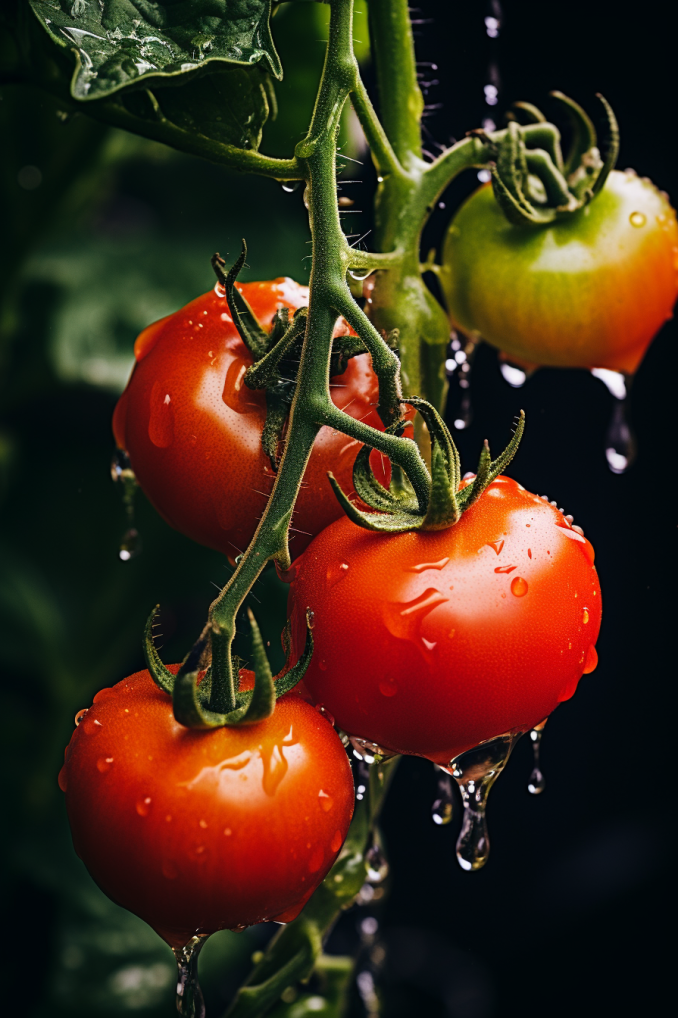
Creating a cost-effective and efficient drip irrigation system for your tomato plants is a rewarding venture.
Follow these steps to set up your own system using tubing and drip emitters:
Materials needed
- Tubing: Select a durable and flexible tubing material, such as PVC or drip tubing, based on the size and layout of your tomato garden.
- Drip emitters: Choose appropriate drip emitters or hoses that regulate water flow. Consider adjustable emitters to customize water distribution for different plants.
- Connectors and adapters: Acquire connectors and adapters to assemble the tubing sections and connect them to a water source. Ensure compatibility with your chosen tubing.
- Support stakes: Use support stakes or clips to secure the tubing above the ground, ensuring proper alignment with each tomato plant.
Step-by-step guide
- Layout planning: Assess your tomato garden layout and determine the placement of plants. Plan the tubing route, ensuring it reaches each plant with sufficient length.
- Cutting and connecting tubing: Cut the tubing into appropriate lengths using scissors or a tubing cutter. Connect the tubing sections using connectors and adapters, forming a network that reaches all plants.
- Attaching drip emitters: Install drip emitters at the base of each tomato plant. Adjustable emitters allow you to control the water flow for individual plants based on their water requirements.
- Securing the tubing: Use support stakes or clips to secure the tubing above the ground, keeping it in place and aligned with the plants. Ensure the tubing doesn’t sag or kink.
- Connection to a water source: Connect the tubing to a water source, whether it’s a faucet, hose, or dedicated irrigation system. Use appropriate adapters to secure a watertight connection.
- Testing and adjusting: Turn on the water source to test the system. Check for even water distribution and make adjustments as needed. Ensure each plant receives sufficient water without excess runoff.
Soaker hose watering method
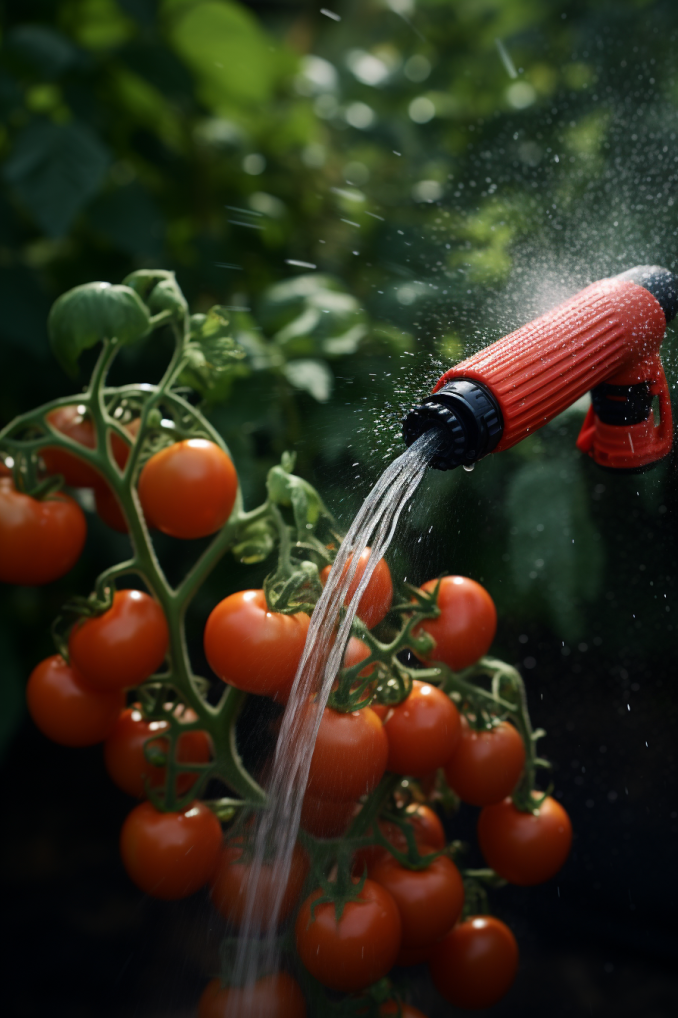
Embracing the soaker hose watering method is a strategic approach to providing your tomato plants with the hydration they need.
This method involves laying porous hoses along the base of your plants, offering a slow and deliberate release of water. Below, we delve into the details of this efficient watering technique:
Materials needed
- Soaker hoses: Invest in quality soaker hoses made from durable materials. The porous nature of these hoses allows water to seep through gradually.
- Connectors and adapters: Acquire connectors and adapters compatible with your soaker hoses to ensure a secure and leak-free connection.
- Support stakes or clips: Use stakes or clips to secure the soaker hoses along the base of the tomato plants, preventing movement and ensuring proper alignment.
Step-by-step guide
- Layout planning: Assess the layout of your tomato garden and determine the positioning of each soaker hose. Aim for a layout that provides comprehensive coverage to all plants.
- Placing the soaker hoses: Lay the soaker hoses along the base of the tomato plants, ensuring that they are in close proximity to the root zones. Secure the hoses with stakes or clips to prevent displacement.
- Connection to a water source: Connect the soaker hoses to a water source, whether it’s a garden hose or an irrigation system. Use appropriate adapters to establish a tight connection, minimizing water wastage.
- Adjusting water flow: Turn on the water source and allow the soaker hoses to release water slowly. Monitor the flow and adjust it based on the water needs of your tomato plants. Achieve a balance that ensures thorough watering without excess runoff.
Rain barrel water harvesting
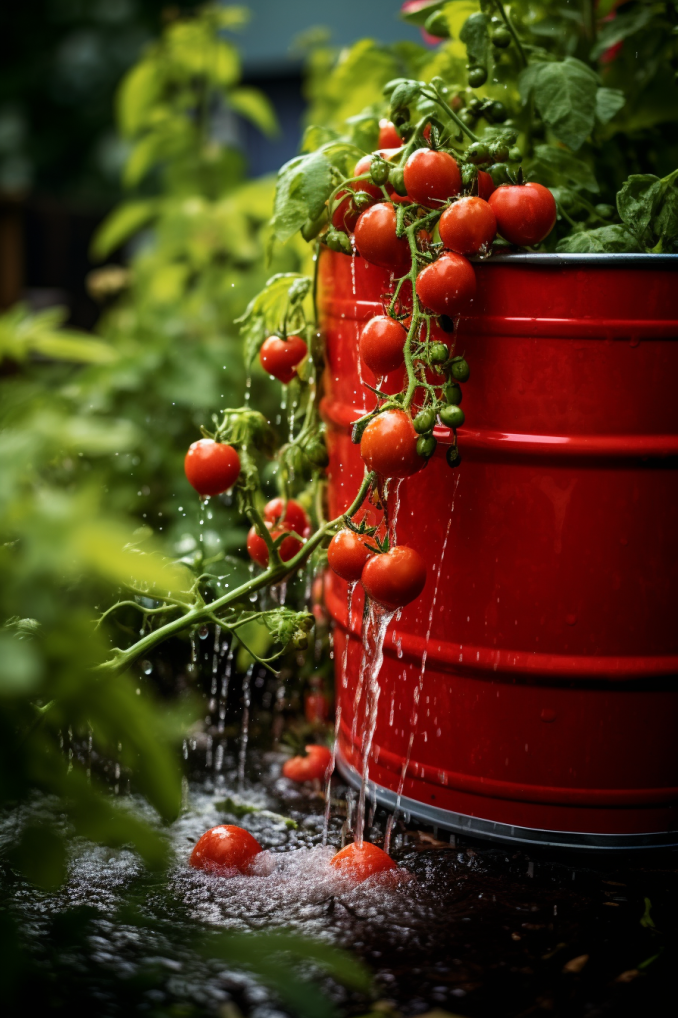
Harnessing the power of rainwater through a rain barrel is a sustainable and eco-friendly method to nourish your tomato plants.
This approach not only conserves water but also offers a natural source of nutrients for your garden.
Let’s delve into the details of rain barrel water harvesting:
Materials needed
- Rain barrel: Acquire a durable and food-grade rain barrel with a secure lid to prevent debris and contamination. Position the barrel strategically to collect rainwater efficiently.
- Gutter system: Connect your rain barrel to a gutter system to channel rainwater from your roof. Ensure the gutter is clean and free from debris to maintain water quality.
- Overflow diverter: Install an overflow diverter to redirect excess rainwater away from the foundation to prevent flooding. This ensures a controlled and efficient rainwater collection process.
- Screen or filter: Place a fine mesh screen or filter at the opening of the rain barrel to prevent debris, leaves, and insects from entering the barrel. This maintains water quality and prevents clogging.
Steps for rain barrel water harvesting
- Positioning the rain barrel: Place the rain barrel beneath a downspout or gutter to collect rainwater efficiently. Ensure it is on a stable surface and elevated for easy access to the spigot.
- Connecting to the gutter: Use a downspout diverter to direct water from the gutter into the rain barrel. This connection ensures a continuous flow of rainwater into the barrel during rainfall.
- Installing an overflow diverter: Attach an overflow diverter to the rain barrel to manage excess water. This prevents overflow and potential flooding around the foundation.
- Adding a screen or filter: Secure a screen or filter over the barrel’s opening to filter out debris and prevent contaminants from entering the water.
Troubleshooting Common Watering Issues
Ensuring your tomato plants receive the right amount of water is crucial for their health and productivity.
However, various issues may arise, impacting the effectiveness of your watering system. Let’s troubleshoot and address common watering issues to keep your tomato plants thriving:
Uneven water distribution
Potential Causes
- Clogs in hoses or emitters
- Incorrect system layout
Troubleshooting steps
- Inspect hoses and emitters for clogs, removing any debris that may hinder water flow.
- Adjust the layout of your watering system to ensure even water distribution across all plants.
Soil drainage problems
Potential causes
- Compacted soil
- Poor soil drainage
Troubleshooting steps
- Incorporate organic matter, such as compost, into the soil to improve its structure and drainage.
- Adjust the slope of the soil to prevent water pooling around plants, especially in areas with poor drainage.

- Read also: DIY Plant Watering Globes
- Read also: The Ultimate Aloe Plant Watering Care Guide
Conclusion
As you embark on the journey of growing vibrant and fruitful tomato plants, remember that the key to success lies in a thoughtful and efficient watering system.
By understanding the benefits, factors influencing water requirements, and signs of overwatering and underwatering, you empower yourself to provide the optimal care your tomato plants need.
Explore the various watering methods, troubleshoot common issues, and witness your tomato garden flourish with health and abundance. Happy gardening!


